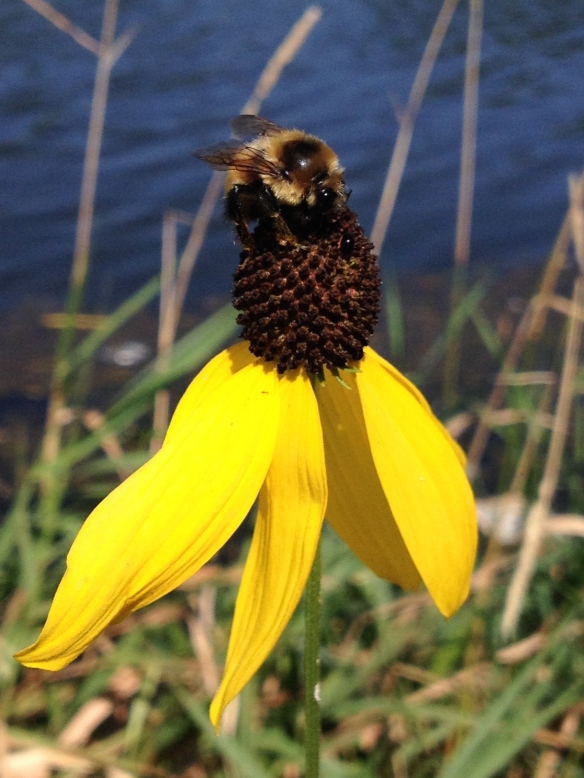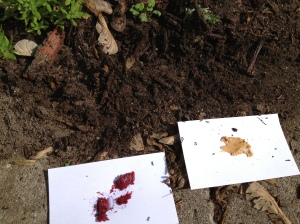I started this blog in January 2010. My sons were nine and thirteen, I’d just been through a divorce, and I was trying to recover from the trauma surrounding it. We’d been homeschooling for several years, and that constant kept the us mostly upright, but life was hard. I started blogging about life in general in 2008 (Finding My Ground), and, from what I can see, I didn’t have much to say about it at that point, so I initially focused on homeschooling. I guess that topic was more manageable. But that year, and the few after it, remain a blur.
Writing about homeschooling gave me another focus as well as a place to share my experiences educating gifted boys. A few years after starting my Finding My Ground blog, I started teaching Other People’s Children, a genre of children that delight and amaze me often because they are so familiar yet so their own selves, all while not being children I had to coax to bathe, woo to complete assignments, and exhort to clean up after themselves. It turns out that it’s far easier to teach Other People’s Children than it is to teach one’s own. It also pays better.
My sons, now 20 and 24, are grown and mostly flown. They’ve turned out decently (read: It was a rocky and scary road for many years, but we are all safe and connected now.) They are still gifted humans, but, in the adult world, it’s often drive, focus, and persistence that seem to matter most. Thankfully, they’ve mostly sorted that out as well. They are kind humans who care for others and do not tolerate discrimination or hate. They call or visit their parents on holidays, and they own their mistakes while understanding what went into their successes. And they are, mostly, happy. I couldn’t ask for more.
I’ve often wondered if attaching ourselves to the gifted child community has been worthwhile or not. Yes, it’s nice to feel like you’re in a special club of sorts, one that doesn’t blink when your four-year-old discusses the Roman Empire or side-eye you when they find out your nine-year-old is studying algebra. It’s helpful to know how to navigate the school scene with a child whose writing skills rudimentary while having a complex understanding of weather patterns and storm cells. For those with twice-exceptional kids (gifted with learning differences), contact with others in the 2e world is almost essential.
But there is another side of community and the gifted child: Competition feels fierce at times. Parents are delighted to “find their tribe” through gifted pages online and other communities, but message boards (which was all we had years back) and social medial threads can make a parent feel like they’re doing it wrong or even that their child isn’t really gifted. Reading about a second-grader who just finished writing their first novel can make you pretty anxious about your fourth-grader who is still struggling to craft more than a sentence or two. Add in the numerous (and often excellent) summer programs and beyond-school academic events, a child taking weekly piano lessons from not-a-concert-pianist and playing soccer in the not-travel-club may seem…disadvantaged.
I am, though, grateful for the community I’ve had for myself and for my sons. Perhaps the most significant gain for me was the friends that came along with homeschooling, and not just those who were homeschooling gifted kids. Homeschooling can be isolating and overwhelming. It feels like an endless buffet of educational options, all claiming to be The One. (Spoiler: There is no perfect book/class/lecture/group, but there are ones that work better for a particular child at a particular time in that child’s life.) So it’s people–often moms, but more dads as time goes on–who help you sort through those options. For me, these people who’d walked this road before me were my lifelines. They not only helped me pick a math book, but they also helped me find my way through the challenges of being both teacher and mom. They provided models of what homeschooling can be, models that fit their family at that particular time.
And they taught me that sometimes it’s best to step back and let your child learn from someone else or somewhere else. What I love about today’s homeschool world is how many “someone else’s” are in available. My sons’ “somewhere else’s” were informal classes started by homeschooling parents, lessons on how to build a computer from a neighbor, workshops on financial literacy, an owner of a tropical fish store, and walks in the woods guided by experts of those woods. My sons took classes online as well — some worked well, while others didn’t, but isn’t that just how life goes?
My sons learned from their real-life experiences as well: Both held jobs in high school (and I can’t urge homeschoolers enough to make work experience part of their child’s education). It broadened their worlds dramatically, more so, I’d dare to say, than a $3,000 two-week summer academic program at a prestigious institution. No, there’s nothing wrong with that expensive camp/academic experience, but remember that kids grow up to be adults that need to function in that adult world. To do that, they need to handle money that they’ve earned. They should have obligations beyond classes — being responsible to someone other than themselves and their parents is crucial.
So here I am, sitting on the other side of homeschooling. I have one son in college–a pre-med who pushes himself hard and likes it that way. I have another son sorting out what comes next, working until he figures it out. I’m proud of both of them, and while we’ve had our ugly moments (and months), we’ve moved to having adult relationships with one another, and I love that move. I’m the only one still homeschooling — or at least homeschooling other people’s children. I am continually amazed by these brilliant young minds and honored to be a part of their lives. I’ve enjoyed watching them grow, as they, too, find themselves on the other side of homeschooling as they launch into whatever comes next.
Homeschooling, Pandemic Style
What you did last spring was not homeschooling.
Seriously. It wasn’t. No one would ever consider homeschooling if that was actual homeschooling.
What you did last March or April was something entirely different. It started virtually overnight with content quickly cobbled together by teachers who were scrambling to take their vibrant classroom curriculum to Zoom, Google, and other not-live-classroom settings. It was emergency virtual schooling done by teachers who were completely dedicated to making things work who were often overwhelmed in the process. Who wouldn’t be? I can’t say my first days seeing patients via telehealth went any more smoothly than those first Zoom classes did. At my clinic job as a PA, I felt useless at points, unable to listen to my patients’ lungs and hearts, unable to really sort out that rash. (“Bring the phone a little closer…closer… BACK UP FROM THE CAMERA!! So, does it itch?”) It’s medicine of sorts, but it’s hardly an excellent physical exam.
What you’re considering now, most likely, is real homeschooling. It’s better than what happened in the early Spring, I promise. You choose the curriculum, formal or not. You decide how much time you’ll spend each day and each week. (You might be surprised how many homeschoolers manage with four or even three days of structured learning.) You decide what’s worth learning at that time. Yes, if you’re returning your kids to school when the pandemic ends, you may want to keep an eye on your school district’s general goals for a given year, but that’s often optional.
Actually, a lot of it is optional. And that’s scary, especially for those of us worried that somehow our kids will get behind. But when your alternative is gluing your kids to Zoom classrooms all day or deciding whether those half-day in-class sessions are worth the risk, “scary” is relative.
I took the homeschooling plunge when my older son (now 23) was seven years old. He’d been unhappy and bored in two schools, and he was becoming discouraged and depressed. He’d decided he wasn’t smart because, per his logic, no one gave him anything hard to do. I’d been preparing for this possibility for several months (an advantage, to be sure), and thanks to some good friends who let me explore their materials and minds, I felt confident enough to bring my son home.
It was a huge relief. The best thing I did was to start gradually. I didn’t launch us into all the subjects. Instead, we started with the Civil War (his choice) and math (his passion). We added more as we went, but seven-year-old brains are sponges. They learn easily and happily (most of the time), assuming you’re remembering that the educational process is about them and not about checking boxes. It’s about learning at a comfortable rate. It’s about being appropriately challenging. It’s about making your child’s world a bit bigger. It’s about learning to love learning.
So when he first came home, we watched the Ken Burns series on the Civil War. We read books about the war. We explored maps and even made a board game about that time in history. We made hardtack. (A learning experience, although not one we repeated. Yuck.) We asked questions and, as this was pre-internet learning time, we went to the library to find answers. Aside from the board game and the hardtack, little was produced. (Very few trees died those first few years with my older son, who hated writing — and struggled to write, thanks to a learning disability.) What he did was learn. Oh, did he learn.
Yes, we bought curriculum. We liked some of it. We loved some of it. And some just sat until it found another home. (It’s okay to let it go if it doesn’t work for you, although note that what works for one child might not work for another. Honor those differences, unless you love conflict. I’ve made that mistake.) We eventually wandered into online classes, with Online G3 being our go-to vendor. My older son tried Art of Problem Solving, but the format didn’t work for him. (It’s an amazing program for the mathematically inclined, which my older son was, but, like anything else, it’s not for everyone.) My younger son benefitted from high-school level Well Trained Mind Academy classes and a host of other online options. There are more options available than one could ever try.
And that’s part of the challenge. There is so much out there, and it’s easy to think that you’re doing it wrong because you are using the wrong curriculum or are t. It’s impossible to explore all that’s out there, and yet it seems, at points, irresponsible not to explore all of it. It is, after all your children’s education you’re managing here. It’s their future. And if they don’t write more than a paragraph until they are ten or failed to learn any foreign language despite several tries with several languages, you’re a terrible homeschooling parent and your kids are, well…behind.
Poppycock. Yeah, it’s poppycock.
Sure, if they are returning to school the next year, benchmarks matter. Maybe. It’s an odd time, after all. I’d guess school’s going to be a bit messy for several years to come, even once our children are back in classrooms that feel like the classrooms they left in March 2020. You may, however, decide to keep homeschooling after this pandemic ends. You might come to like the time with your kids, watching them learn and learning along with them. You might enjoy the freedoms it affords: days off because you need a day off, less opportunity for illness, control over content and pace, room for your children’s passions, and more free time overall.
And if you don’t enjoy it, that’s okay, too. It’s not for every parent or every kid or every school year. It’s not a failing to hate it or to find it tedious. It’s hard at first, or it often is. We have expectations, the kids have expectations, and we’re all together all the time. It’s intimate, homeschooling, and it can be intense. It’s as much a lifestyle as an educational option.
What you did mid-second semester in 2020 was not homeschooling, though. Don’t judge homeschooling through that lens. Look, instead, as homeschooling for the next year as an opportunity to look at education differently and to know your children a bit better. Watch how organically they learn, and celebrate what they learn. Let them teach you — you’ll learn a good deal. You’ll have some bad days — and a few astoundingly bad days. Learn from those and move forward. Homeschooling might just be something that lasts beyond this pandemic.
Uncharted Territory
As of August 16, 2019, there are seats available in several classes, including the six-week workshops. Two more are offered in Spring 2020.
by Sarah Butler
The book had me at the table of contents: Education, Credo, Power, Relationships, Decisions, Identity, Freedom, and Success. Eight chapters full of short stories, essays, and poetry exploring the concepts our children wrestle with as they find their way to adulthood. Well, we all wrestle with them, but this series of workshops is for the kids. (Sorry, parents.)
These 6-week workshops, two offered each semester, carry part of the name of the text that enchanted me: Uncharted Territory: A High School Reader, edited by educator and writer Jim Burke and published by Norton. The pieces span centuries and continents, philosophies and points of view: an excerpt from Machiavelli’s “The Prince” and the James Madison’s Bill of Rights share a chapter with many an introvert’s hero, Susan Cain, whose book Quiet reassures many of us that staying at home with book is a valid way of being in the world, and a TED talk by Chimamanda Adichie, a Nigerian-born woman who explores the complexities of race, social status, and family in her novels and short stories.
Uncharted Territory workshops focus on the topics that our teen learners are confronted with in their own lives and in the bigger world. It’s in those years that we start to ponder where we fit into the world and how we will manage the big questions of life. It’s at this point we wonder about who we are (Identity), wrangle with the many choices that present themselves (Decisions), ponder our way of being and believing (Credo), and struggle to find our voice while sorting through the voices of others (Power).
But these workshops go beyond inward gazing and reflection. The Uncharted Territory workshops focus on the skills our children must have to manage the complexity of today’s world, where we are ever-more connected and yet ever-more divided. It’s also the world where we are ever-more bombarded with information. Our kids are reading books and blogs, watching YouTube and listening to podcasts, participating in online discussions as well as those around the dinner table. Despite the variety of media available to them, they, like us older folks, tend to drift to sources that grab them by their emotions and predilections. Unlike us older folks, they don’t often have the experience or critical reading and thinking skills to sort which podcasts, news outlets, and Twitter feeds are worthwhile and trustworthy and which are not.
Therefore critical reading and thinking skills are a big part of the Uncharted Territory experience. These are pieces written by the pros — by experts in their fields and authors, many with long lists of celebrated publications. That doesn’t mean that what each author says is perfect or even entirely accurate. Sometimes it is the march of time that makes us have to turn over an old idea and see if it still holds today. Other times it’s a matter of our own biases: We push against what we read because we’re holding tightly to one idea, making it hard to see another point of view. To be sure, there are points of view that can be quickly discarded: we don’t glorify hate, deception, inequity, or violence, but we do explore how those — have shaped our world and how they can be diminished. We read, therefore, with our eyes open and our minds ready to evaluate and analyze. In-class discussions and weekly forums, students have the chance to do those tasks with their classmates, and in their writing assignment (one each workshop, with two drafts, each given feedback by the instructor).
So we’ll spend each webinar discussing readings as they relate to the theme of the workshop (Power and Identity first semester, followed by Credo and Decisions second semester), exploring the content of the reading as well as the context it is in. Context — the setting of the piece — is an oft-overlooked element of a piece of writing. It includes the time and place in which the author is writing: An Iranian-born graphic memoirist from the 21st century has a different look at how one develops a credo, or philosophy of life, than, say, an American essayist and poet from the mid-nineteenth century. We’ll also tease out rhetorical skills and literary devices, adding to their toolbox of writing skills.
These workshops are both English classes with reading and writing assignments (and a pair of them in a semester could be considered a full English class), but they incorporate the other subjects that make up our world. We’ll discuss history, sociology, philosophy, government, psychology, and science. We’ll welcome the complexity of these subjects and wrestle with the challenging questions raised by the readings and our own reflections on those readings. And we’ll have fun along the way.
So send your teen on an exploration of the vast world of the written word and the themes that drive people to write those words. Support their journey to become better critical readers, thinkers, and writers. It’s good for them. It’s good for the world around them. (It could count towards or for an English credit.) And it’s going to be terrifically fun.
Sarah Butler is also known as Coach Cordelia at OnlineG3.com. She teaches writing at G3.
Review: Amazing Ants–Simple Sidewalk Science (Royal Fireworks Press)
 My kids spent their homeschooling childhoods watching animals go about their lives. Often, we observed animals in their natural habitats: robins, poking for worms in the yard; bees, collecting from flowers; and, of course, ants, scurrying about their business. We also observed our “kept” creatures: fish and aquatic frogs in their tanks, gerbils and guinea pigs in their cages, foster cats just about anywhere in the house, snails and slugs in a terrarium, and, of course, ants in a plastic shoe box. My father, Barkley Butler, brought us to ants, and, over time, he taught my sons (and me) a good deal about how to do science. W. Barkley Butler, Ph.D., spent the first portion of his career in the lab in cancer research before moving to Indiana University of Pennsylvania (IUP) to teach biology. It’s there that he started to use ant study as a teaching tool. Ant interest led to a few weeks at Ant Course, which led to more ant study, which then led to this book.
My kids spent their homeschooling childhoods watching animals go about their lives. Often, we observed animals in their natural habitats: robins, poking for worms in the yard; bees, collecting from flowers; and, of course, ants, scurrying about their business. We also observed our “kept” creatures: fish and aquatic frogs in their tanks, gerbils and guinea pigs in their cages, foster cats just about anywhere in the house, snails and slugs in a terrarium, and, of course, ants in a plastic shoe box. My father, Barkley Butler, brought us to ants, and, over time, he taught my sons (and me) a good deal about how to do science. W. Barkley Butler, Ph.D., spent the first portion of his career in the lab in cancer research before moving to Indiana University of Pennsylvania (IUP) to teach biology. It’s there that he started to use ant study as a teaching tool. Ant interest led to a few weeks at Ant Course, which led to more ant study, which then led to this book.
Amazing Ants: Simple Sidewalk Science, by Dr. Butler and published by Royal Fireworks Press, written for gifted students at the middle school and high school levels, is an accessible and yet scholarly walk through not just ant study but also “real science”, which the author defines as the act of raising new questions and providing new information. Amazing Ants walks its readers through the process of doing science, starting with observation and leading to the presentation of results in a full research report. It is a text and a notebook in one, with a rich set of resources as well. While that scope may seem optimistic (or overwhelming), Amazing Ants manages to comfortably move the reader from the observation of the natural world that they’ve done all their lives to more scientific observation then study in a comfortable and encouraging way.
Science starts with observation, and Amazing Ants’ initial approach to observation has readers down on their knees, scouring the grass, examining plant stems, flipping rocks, and simply staring at the pavement. After a bit of attention to tools needed (not many, and easy to find) and few general ant facts with references, Amazing Ants dives into how to observe like a scientist by setting up simple bait stations. As the book walks the reader through the basics of drawing out ants with carbohydrates, proteins, and fats (all terms he explains clearly along the way), it teaches scientific process as well as those science basics.
After students have honed their baiting and observation skills, Amazing Ants dives deeper. It reaches beyond the usual question of “Why do you think you saw what you saw?” to help the reader appreciate how complicated it can be to sort out those whys. The book walks the reader through “taste tests” for ants that move the young scientist from simply observing to truly understanding the complexity of the data the studies provide. What does it mean if more ants went to one substance more than another? Explorations of sugar concentration, availability of food, and other variables are woven into the fabric of the exploration process, again with all terminology (including some information about concentrations of solution) that reach well beyond the general knowledge many of his readers. Amazing Ants accomplishes this with language and tables, along with a tone that makes the reader feel like the author is sitting right next to you.
Amazing Ants then introduces the reader into the basics of data collection and data analysis, two areas I can’t say I’ve seen addressed thoroughly in any grade-school or many middle-school science resources. Again, the language is accessible and the examples are helpful. The book then explores variables, graph options, averages, percentages, and even ratios, all in the context of the ant observations and experiments discussed previously. There’s even a section explaining how data can be manipulated a discussion ethical representation of data. That’s pretty impressive for a text written at a middle-school reading level.
At this point, the book sees the student as a scientist and guides readers through three experiments relying on the procedures and math learned in the previous chapters. For each, the reader is lead through a sample experiment about food preference, habitat, and ant behavior. After the instructions for each experiment, the author provides several “challenges”, which are really inquiries that the student could use to design their own experiments or to help them sort out more questions of their own: they are to actually “do” science. For students who want to present their findings, the book includes a section on the anatomy of a research report as it would appear in a scientific journal and as a poster for a scientific meeting. No, not every reader will need that information, but budding scientists entering science fairs or considering science as a career might give those sections some serious consideration, and certainly teachers or parents could teach the process of those forms of scientific communication with the help of those resources.
While labeled as an Appendix, the last third of the book deserves far more reader attention than most sections with that name. This section contains print and web resources about ants and instructions on collecting and maintaining your own indoor ant colony. No, this isn’t the glass sandwich ant colony of my childhood but rather a simple yet secure way to keep a colony inside, allowing observation of a colony over time and in the ant offseason. To answer the inevitable adult question, no, the ants don’t escape, or at least that’s not been our experience if you follow the straightforward directions. Over the years, my sons and I nurtured several colonies with the plastic shoe box method without mishap, and it was simply a fascinating way to observe the behaviors that are hard to study in nature.
As a homeschooling parent with a passion (obsession?) with science and science education, I can say that this book brings science exploration at home or in the classroom to a much higher level than I’ve seen previously. Not only does Amazing Ants teach ant study, but it also teaches inquiry-based science in a way that both parents and science educators can easily implement. Far too many science texts and classes shy away from true inquiry-based learning, and for understandable reasons. It’s often hard to know where to start and just how to guide students in scientific study, and that can mean it’s all too easy just to stick with experiments with certain outcomes that don’t require the sort of imagination and curiosity that real science requires.
But this book doesn’t require an adult lead to make learning happen. Yes, Amazing Ants would be an excellent resource for a nature summer camp, a co-op class, or a homeschool science study directed by a parent. But it is also written to go directly into the hands of the student. Amazing Ants is written directly to the student, with a teacher’s note appearing only at the end. It’s written with clarity and passion, and with the assumption that the student has this in hand. It respects the reader, supports the reader, and challenges the reader. It makes science more than just “fun”: It makes science real and important and possible while also making it accessible and understandable. Now that’s amazing.
Disclaimer: My father, W. Barkley Butler, is the author of Amazing Ants, and Royal Fireworks Press has provided me with a copy for review. My enthusiasm for this unique and brilliant book is genuine, though.
A Letter from the Counselor
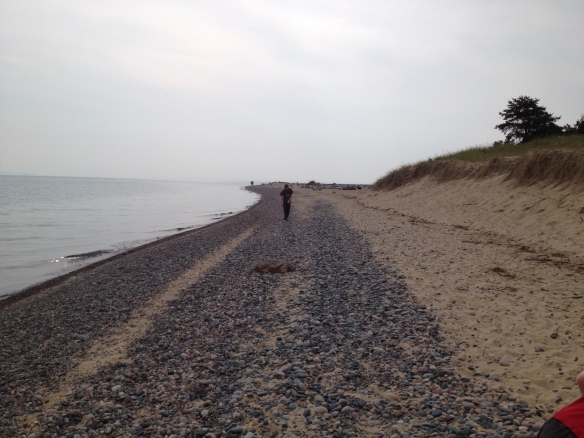 I have a high school senior, and it is November — college application time. It’s that season for seniors everywhere, an intense push to whittle down lists of schools you know only a bit about while choosing an area of study that may seem completely divorced from the world of work that lays ahead. For most student, it’s an exciting, frightening, and excruciatingly painful process, depending on the moment.
I have a high school senior, and it is November — college application time. It’s that season for seniors everywhere, an intense push to whittle down lists of schools you know only a bit about while choosing an area of study that may seem completely divorced from the world of work that lays ahead. For most student, it’s an exciting, frightening, and excruciatingly painful process, depending on the moment.
Parents share the fright, excitement, and pain. We marvel that this being, once entirely dependent, is stepping closer to adulthood. We worry about finances (ours) and readiness (theirs). This storm of emotions is tinged with the knowledge that change is hard even when completely welcome. Sometimes we’re scared, but we’re not supposed to show it.
Homeschooling parents face an additional challenge during college application season. We’ve been principal, counselor, and teacher as well as parent, and thus we not only write the checks but also the transcripts and letters to admissions offices. We answer questions that force us to put the parental hat aside and look dispassionately yet positively at the child who we rocked through colic and whose hands we held while he took his first steps. It’s mental gymnastics with no net and no spotter.
I’d managed to avoid these worries until a few weeks back when my homeschooled senior finished his part of one of five college applications. It was fairly easy for him, with only short answers about interests and activities requiring thought. He’d worried about this process, so he started on a simple on. After a bit of work and some checking and rechecking, he electronically submitted it. Done. Whew.
And then the email came. The one requesting his transcript (so close to done, but needing a few final touches) and a letter from his counselor. That’s me.
I knew this was coming. A few years back, I’d watched a friend work through the counselor sections on college applications, andI recall her concerns, trying to find the right tone to discuss her daughter, an accomplished young woman with plenty of options. She had to explain her homeschooling philosophy as well, something most homeschooling parents have some sense of but often don’t put into words, at least not for people making decisions that affect our child’s future. She had to explain her daughter without gushing but without pointing out the flaws either. It’s hard work for a parent.
So a few weeks back, after much stalling, I donned the correct hat and sat down to write the letter from the counselor, a letter I can likely use for any school that asks for it, but that hardly made it less daunting. I wrote, deleted, and rewrote, not quite finishing but stopping because, like many pieces of writing needing revision, I needed the distance time provides to view it again. A week later, I revisited the letter. It wasn’t as bad as I feared, and it needed only a handful of revisions to obtain the dispassionately positive account that the job required. I ended up pleased with the letter and slipped it into the mail with his transcript.
But something else happened in that letter writing process, something beyond profiling my son for a college option. Before starting the letter, I’d spent weeks staring at minutiae on his transcript, tweaking the font and color scheme (tiny with blue highlight for headings), agonizing over whether to weight his grades or not (yes, but only the college courses and list both unweighted and weighted), and wondering what makes a transcript ‘official’ (the word ‘official’ on it — really). I spent nights wondering if more time on literature would have been worth the agony and if his electronics class was a science or a computer studies course. I’d started to see him only as numbers and lists of classes. But this letter. This letter from the mother who, for a decade had worn the hats of mother, counselor, teacher, and principal. This letter from a mother standing so close to her subject that it appeared as a Pointillism-style painting by Seurat viewed just inches from the canvas. All dots, seemingly random and without connection to one another. This letter pushed me back.
This letter pushed be back from those dots and showed me a full picture of my son. I saw his passion for computers, both their hardware and software. I saw the hours of effort put into helping others, friends, family, and acquaintances who had relied on him for help with technology they didn’t understand. I saw the boy becoming a man who found a way through each technical problem that came his way, the one who thirsted for more knowledge and read more online about his scientific and technical interests than I often likely knew. I saw a competent young man who had so much to give to others, one for whom numbers and lists of classes told only fraction of his story. I saw struggles and victory, hard earned and modestly worn. Between the lines, I recalled defeats, painful but just as important in formation as the successes. I saw a student ready for the next step with plenty to offer a college or workplace because of the person he is, something no transcript can possibly convey.
His college application process continues to rumble on. He’s not enjoying it, and I’m not either. It’s still exciting, frustrating, and somewhat painful, although a bit less than it was. In time, we’ll see who choses him and, more importantly, whom he chooses. While we’re waiting, I’ll keep looking at my son at a bit more of a distance, appreciating him with the passionate love that I had while holding those tiny, soft hands when he learned to walk, letting go, bit by bit, as he was ready. It’s time.
Evolution (but not Religion) in the Biology Classroom
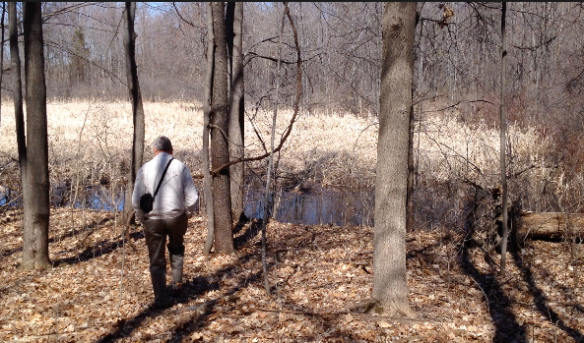 “Now that I’m homeschooling, I’ll be teaching the boys creationism, of course.”
“Now that I’m homeschooling, I’ll be teaching the boys creationism, of course.”
The chuckle I’d expected from my father didn’t come. He paused, unsure what to say. My decision to homeschool my older had somewhat unnerved him, as it wasn’t the typical path, but he was never one to meddle in my life. I’d rarely even seen him pause like that, processing thoughts that were likely previously thought unthinkable. Creationism? How could that be?
“I’m kidding, Dad,” I reassured him, a bit surprised he’d even thought it was possible. He exhaled but still looked a bit shaken. He was then a Biology professor at a state university and is still today a liberal Presbyterian. He is committed to science while believing in God, and he finds no conflict between science and his religion. I was raised with both, understanding evolution and believing in God, never seeing conflict between them. And while I left my belief behind about a decade ago, it wasn’t because of science.
What does it mean to understand biology through the lens of science? It means to understand that from the simplest species to the most complicated, natural selection drives the changes to that species. Genes copy with errors, and errors can wreak havoc with life or increase the chance of an individual surviving to reproduce. And that’s what life (in the biological sense) is all about — making more of a species. From antibiotic resistance in bacteria to the form and function of the mammalian eye to the modern human today, evolution is the driver. It’s wily driver, without direction or purpose. Every slip of DNA’s copying mechanism is random, with ‘goodness’ or ‘badness’ relative to where the alteration occurred, what (if any) effect it has on the organism, and even the environment in which that organism lives.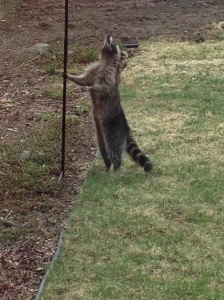
To teach biology without this understanding is to miss much of what biology is. To limit evolution to that bacteria’s antibiotic resistance or the finch’s beak is to mangle the very mechanism of change in the living world. It’s akin to teaching composition without discussing grammar. Evolution is how change happens, and biology can only be fully understood by appreciating that overarching truth in science.
So a few weeks back, when I tucked into evolutionary biologist’s David Barash’s recent opinion piece in the New York Times, God, Darwin, and My College Biology Class, I found myself nodding along. Barash begins his undergraduate animal behavior class with what he calls “The Talk.” This lecture affirms that his class with look at all of biology through the lens of evolution, a statement I make on my biology syllabus for the classes I’ve taught my sons and their friends and that other families have used as well. I admittedly have an advantage, as my students are known to me and from families where creationism isn’t part of the curriculum. And so evolution simply permeates the class, with religion rarely brought up. It is, after all biology class.
Barash’s classes are more diverse than my tiny home classroom, and I imagine my father’s were similarly diverse. College biology may be the first place conservative Christians rooted in creationism or, its euphemism, Young Earth creationism, may first experience biology through that lens of evolution in a way that affirms the process rather than denies its validity. That could easily put a student on guard, worried about veracity of the rest of the course or thinking about at least part of his or her faith. I’d agree is seems wise to warn — or at least inform — the class of the lens in place. That should be sufficient.
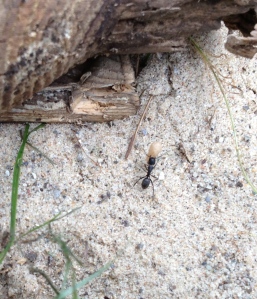 I can’t recall any reference to religion in any of my biology courses in either my Catholic high school or Catholic university. Religion wasn’t mentioned, and no one every asked, as far as I recall, if it should or shouldn’t be discussed in the science classroom. Barash takes the offensive, as he starts with a talk about religion and science. He doesn’t stop at stating that evolution is the underpinning of biology, and that all will be discussed through that lens. He does not hold, as I do (and as does Stephen Gould) that science and religion are “non-overlapping magisteria,” meaning they have separate domains and are, therefore, compatible understandings in a single human being. Instead, Barash tells his students that religion and science do overlap in domain, and that accepting evolution demands deconstruction of any belief in “an omnipotent and omnibenevolent God.”
I can’t recall any reference to religion in any of my biology courses in either my Catholic high school or Catholic university. Religion wasn’t mentioned, and no one every asked, as far as I recall, if it should or shouldn’t be discussed in the science classroom. Barash takes the offensive, as he starts with a talk about religion and science. He doesn’t stop at stating that evolution is the underpinning of biology, and that all will be discussed through that lens. He does not hold, as I do (and as does Stephen Gould) that science and religion are “non-overlapping magisteria,” meaning they have separate domains and are, therefore, compatible understandings in a single human being. Instead, Barash tells his students that religion and science do overlap in domain, and that accepting evolution demands deconstruction of any belief in “an omnipotent and omnibenevolent God.”
After discussion of the complexity created by natural selection and the illusion of humans as central in the living world, Barash settles into theodicy, an issue far afield of the evolution he sets out to explain. Problems with theodicy (the attempt to reconcile suffering in the world occurring in the presence of an omnipotent, caring deity) contribute to many a person of faith’s loss of that faith. Veering from science, Barash steps broadly into religion, confronting students with the news that if they buy evolution, their faith will likely fall, provided they’re thinking deeply enough:
The more we know of evolution, the more unavoidable is the conclusion that living things, including human beings, are produced by a natural, totally amoral process, with no indication of a benevolent, controlling creator. (Barash)
As an agnostic who sees science through the lens of evolution and the universe as a mystery we ever so slowly unwrap, origin somewhat understood, but only with the most tenacious grasp, I find myself irritated with Barash. Like other militant atheists (and I’m assuming he is an atheist), he forces a narrow lens on what God must be to the believer: God, it seems, must be creator of all, simple and complex, pulling each string and guiding each change. God must create humans as separate, with some of God’s supernaturalness in humans but not other creatures. God must be absent given suffering in the world.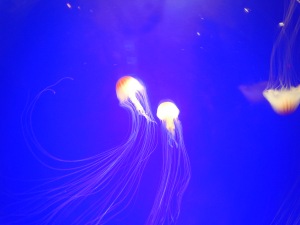
About a decade ago, I left my faith behind. But I didn’t lose it in the science classroom, and I didn’t lose it because I understood that the complexity of life is due to evolution, the roll of the genetic dice paired with environmental pressures. I didn’t lose faith because I understood the long arc of evolution that brought humans into being. I lost it in part to the theodicy question and in part to long thought about what made sense to me. Science wasn’t part of my musing.
My father, a biologist who understands and teaches science through the lens of evolution, a man of faith who is dedicated to helping others of faith, understands that science and faith need not be in conflict. He hasn’t lost his belief, despite decades of science study as a researcher, professor, and interested human being. He, like Barash and I, understand the complexity produced by evolution’s often slow hand, and he is unbothered by the lack of supernatural gene in humans. And the theodicy question? He’s obviously found a way through that one, all while appreciating the science of evolution. And at what cost to his science classes? None.
Barash’s mistakes, in my opinion, are two-fold. First, his view of what God is to a believer is myopic and simplistic. Views of God, gods, goddesses, and divine forces in the universe are as diverse as there are people who believe. Second, his approach is arrogant and presumptive. To tell people who believe just how their faith will be undone is an act of assumed superiority and completely without regard to the personal nature of an individual’s faith. Will some conservative believers, steeped in the absoluteness of a seven-day creation myth struggle as they take biology in a college classroom where evolution is the common currency? Probably. But many believers of all flavors won’t struggle one bit, content with their separation of science and religion.
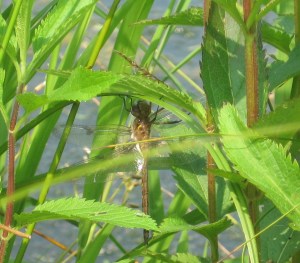 Barash wants to warn his students that, should they retain their faith, they will do so only with “some challenging mental gymnastic routines.” How a nonbeliever can begin to step into the mind of a believer and predict whether the wonders of evolution will deepen or destroy the faith of another is beyond me. Yes, science can challenge faith, especially a conservative faith resting on a supreme being pulling the strings and putting humans above all else. But faith, in many forms, can sit comfortably with the scientist, causing no sacrifice to the scientist’s understanding of the universe and the living things inhabiting it. Barash’s talk forwards his own atheist agenda, and that, in the classroom, is going too far.
Barash wants to warn his students that, should they retain their faith, they will do so only with “some challenging mental gymnastic routines.” How a nonbeliever can begin to step into the mind of a believer and predict whether the wonders of evolution will deepen or destroy the faith of another is beyond me. Yes, science can challenge faith, especially a conservative faith resting on a supreme being pulling the strings and putting humans above all else. But faith, in many forms, can sit comfortably with the scientist, causing no sacrifice to the scientist’s understanding of the universe and the living things inhabiting it. Barash’s talk forwards his own atheist agenda, and that, in the classroom, is going too far.
I believe in freedom of speech and freedom of religion, but when at the front of the classroom, I believe you have a responsibility that includes knowing your boundaries. If you’re a biology teacher, teach science. Unabashedly teach evolution and say that you’ll do so. Talk about complexity. Ignore creationism, as it’s not science. And ignore God, whether you believe or not, as faith isn’t part of science. Encourage students struggling with the concepts to discuss their struggle with classmates, their religious leader, their God, or anyone who will listen and let them sort through. But stay out of the wonderings and wanderings of their faith.
I teach biology through the lens of evolution. I’m an agnostic. My father, on a far larger scale, did the same for decades. He’s a Presbyterian. It works.
Cross-posted on Finding My Ground, my personal and religious blogging home.
October 16: Opposing viewpoints are welcome as long as they are on point and respectfully presented. I’m glad to have a conversation that is respectful. All comments will be held for moderation to assure conversation remains civil.
Beyond Curriculum: Teaching Science and Scientific Thought (Essential Skills Series)
See Essential Skills for a Modern World for an overview of this series on science and critical thinking skills. I discuss science and scientific thinking in the post Follow the Ant and curriculum in Curriculum for Teaching Science and Scientific Thinking. Critical thinking is up next. Stay tuned.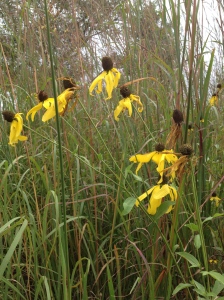
“Mom! Look at this!”
I leave my vegetable garden to join my younger son in his crouch over the remains of a parsley plant. Just days ago, we’d picked a few healthy sprigs for a soup, but today, I can only find a few intact leaves. What happened?
“Look, mom!” My son points at a small caterpillar stretched across a stem, inching toward the remains of a leaf. We watched, silently, focused on our visitor/thief. It took a moment before I saw the rest of them, six or ten similar caterpillars marching and munching. At only a few centimeters long, skinny with yellow, black and white, they were attractive. Fascination quickly replaced annoyance with our garden guest as we explored the nearby plants, inspecting them for visitors and damage. Only the parsley was eaten, with the flower to its right and the tree to the left untouched and uninhabited.
After a long observation, we went inside to research what we’d seen. Using an insect field guide, we identified the caterpillar as the larval stage of a swallowtail butterfly, common to our area. We returned the next day to check on our friends, but they’d stripped the plant and, apparently, moved on. The parsley plant rebounded, but was never touched again that season. We never finding a pupae nor an adult swallowtail. We’d done science, though, and that was satisfying.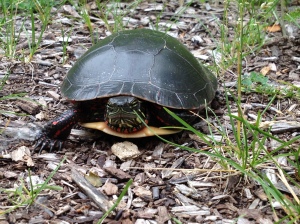
My children’s science education started early, although it was one of the last subjects I taught formally. Before my older son was three, I named the plants for him. Hydrangea. Tulip. Black-eyed Susan. Boxwood. Dandelion. I’d named other parts of his world: His trains from Thomas the Tank Engine. Animals at the zoo. Colors. Letters. Numbers. Foods. Adding the flora of our yard just made sense. Is naming science? Certainly. Naming fills the sciences. Our planets, stars, and galaxies have names, as do elements and compounds. Taxonomy alone would make for a meager science education, but it’s a lovely place to start.
Naming gives a common language for what happens next in a child’s science education: Questions. While “What’s that?” is the refrain of the toddler, “Why?” is the mantra of the preschooler. Sometimes, we don’t know. It’s okay to say that. We’d be wise to model their question-asking by wondering aloud back to them. Why does the bee sting? Why does the ice melt? Why do the stars twinkle? Why don’t the planets? We can ask without answering, allowing time for wonder.
Scientists, the ones in labs and in the field, after all, don’t have all the answers. They have questions that are borne from observations paired with wondering, and they look for answers, but answers, the hard and firm kind, are often elusive, and life-long scientists are used to having more questions than answers.
Teaching our children and ourselves science and scientific thought required that we do three things:
- Observe the world, both natural and technological, naming what can be named.
- Name what you see. If you can’t name it, see if you can get close.
- Ask questions about what we see, wondering how that world works.
- Through research, experimentation, and more observation, pursue answers to those questions.
 It doesn’t require the right curriculum (or any at all) or an advanced degree in science or math. It simply requires curiosity and the willingness to think about what is, wondering why and searching for answers.
It doesn’t require the right curriculum (or any at all) or an advanced degree in science or math. It simply requires curiosity and the willingness to think about what is, wondering why and searching for answers.
Observation is simply a matter of practice. Take time to follow the ant. Watch the clouds move across the sky. Take off the back of your computer and look around. Turn your houseplants and watch their leaves turn back to the light. Take a magnifying glass to the mold on your bread. Watch yeast come to life when you go to bake new bread.
Observation can go beyond our homes and haunts. Nature and science videos — well done ones from reputable folks (most NOVA, Cosmos, David Attenborough, etc.) offer fine views of what we can’t see locally. The internet offers us even more, although use caution when taking your science observation online. Not all you may see is real, and using good critical thinking skills to sort through sites is a must (more on those skills in the next post). NASA.gov takes us to the stars and beyond. The Periodic Videos bring us chemical reactions we should not try at home. BBC Nature provides images of the very big, very small, and very hidden. While nothing beats observing the natural world unfold in real life, these sites and more can bring the big, small, and hidden into view.
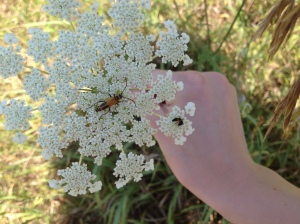 Name what you see. Our best research tools at home are a set of field guides. While we buy some new, we’ve picked up most at used bookstores over the years. (Don’t be put off by old editions. A cardinal from the 1960s is still a cardinal, although given climate change, you may want a more current source for its geographic range.) Find guides for flowers, birds, trees, garden plants, clouds, and rocks and more. Yes, you could use guides designed for cell phones, but, for me, it’s easier to page through pictures in a pocket-sized field guide, looking for a match than to peer in bright sunlight and tiny images on my phone. Either way, look it up. Name what you’re seeing.
Name what you see. Our best research tools at home are a set of field guides. While we buy some new, we’ve picked up most at used bookstores over the years. (Don’t be put off by old editions. A cardinal from the 1960s is still a cardinal, although given climate change, you may want a more current source for its geographic range.) Find guides for flowers, birds, trees, garden plants, clouds, and rocks and more. Yes, you could use guides designed for cell phones, but, for me, it’s easier to page through pictures in a pocket-sized field guide, looking for a match than to peer in bright sunlight and tiny images on my phone. Either way, look it up. Name what you’re seeing.
Ask questions. Specifically, teach your child to ask questions by asking them yourself. When first guiding a young child in this process, ask questions you know the answer to along with ones you don’t. It’s good for kids to hear an adult say “I don’t know,” followed by “What do you think?” That’s science. Use naming language in your questions as much as possible. “What’s that male mallard duck doing when he sticks his head under the water?” “How does that penicillin treat your strep throat?” Use the language of science — specific names paired with specific events — as you form your questions.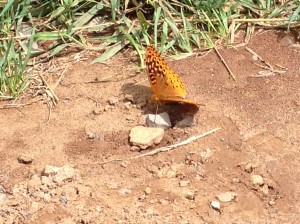
Pursue answers. Look up what you don’t know. Some families keep a notebook handy on walks for questions to look up later. We’re not one of those families. (I figure what we remember to pursue is what caught our attention the most.) Again, be careful of the sites you trust when taking science online.
Then take the next step. Do the experiment. Does the yeast bubble (respiration — releasing carbon dioxide) at a different rate if the water is cold than if it is warm? What does hot water do? If you add a bit of sugar, does that change the process? Plenty of experimentation can be done at home without fancy equipment. Resist buying books of experiments. While these guided demonstrations can lead to better understanding of a principle, they rarely have the child ask the question. Instead, the question is provided along with the answer.
You can use those books of experiments to spur questions, however. Use the lab as a demonstration punctuated with questions like “What do you think will happen if…” and “What do you think is happening?” Or turn a lab into a demonstration and let the questioning begin. Consider the experiment where the hard-boiled egg pulls into a bottle when the flame at the bottom of the bottle burns out. It’s a study of temperature and air pressure. Rather than doing what most experiments do — explanation first with lab later — invert the order. Do the experiment. Then ask questions. For each proposed answer, think about ways to test the answers. Do what’s practical and safe. (And discuss the impractical and unsafe along the way.)
Above all, have fun. Observe the world with curiosity and thought. Name what you can. Ask questions. Search for answers. Cultivate your own and your child’s scientific thinking every day.
Curriculum for Teaching Science and Scientific Thinking (Essential Skills Series)
See Essential Skills for a Modern World for an overview of this series on science and critical thinking skills. I discuss science and scientific thinking in the post Follow the Ant. The recommendations below are based on my experience educating my sons and myself over the last decade. In my next post, I’ll explore other resources for fostering scientific thinking and increasing scientific understanding.
Okay, you’ve followed the ant. Well, perhaps you’ve considered sending your kids out to follow the ant, asking them to return and fill you in, but hopefully you’re thinking about your children’s science education in more practical terms. Here’s a bit of assistance.
Choosing curriculum
Formal curriculum isn’t the most essential part of a child’s or adult’s science education , but I do know it’s what comes to mind when we think about teaching science. For the youngest students, I’d not bother with formal curriculum. Explore the world together. Follow your child’s interests or introduce him to yours. Go to the library and explore the science sections for children and adults. Watch science shows for kids and for adults, but mostly DO science by interacting with the natural world.
When you start selecting formal curriculum, be choosy. Insist on a curriculum that puts science at the center and avoids other agendas. (The scientific process is quite different from theological thinking. Mixing them makes for a poor education in both. Don’t do it.) Look for curriculum that requires the student to ask questions and to think about possibilities. Many texts intended for schools simply don’t do much of that, nor do many of the big-name publishers for homeschoolers. Inquiry science is the formal name for science that puts questions and thought before answers, and, frankly, it’s hard to find. Worry less about tests, as far too many ask for facts rather than concepts applied to new situations, and scientific thinking is a process, not a series of facts. Yes, facts are important, but divorced from doing science, they don’t create scientific thinkers. Look for questions higher up Bloom’s taxonomy, where questions require application of facts, analysis, evaluation, and creation.
Hands-on experiences that do more than show a taught concept are crucial to teaching the observational skills and thought processes necessary for developing strong scientific thinking. After-the-lesson demos may strengthen fact retention but they don’t stimulate the “why” brain as well that the same demo before the lesson. At least some of the labs and hands-on opportunities should require the learner to design the experiment, ideally formulating the question from observations they’ve already made. It’s fine if not all do. There is plenty to learn from cookbook labs, including technique and the range of possibilities of how to answer a question.
Many lab manuals and texts don’t have this focus, either because of the classroom logistical issues when children ask questions and figure out a way to search for answer (for standard curriculum) or parental ease (homeschoolers are often looking for ease of delivery, understandably). If your favorite option doesn’t do this, alter the experiments a bit. Instead of passing the lab worksheet to your child, read it over and think. What’s the question the lab asks? If I give my child that question and the materials in the lab (plus a few — be creative) without the instructions but with plenty of time and some guidance, could my child find a way to answer the question? (In a later post, I’ll give some guidance on altering labs to be more student-driven and aimed at developing scientific thought.)
Even if your curriculum is full of cookbook labs that you’re uncertain of how to alter, don’t despair. Just ask questions not answered by the text directly. Don’t be afraid to ask the ones you don’t know the answers to, and don’t worry about settling on a single answer. You’re better off wondering and wandering to more sources to search for more answers. After all, a good amount of scientific work is research in response to a scientist’s questions. Again, refer to Bloom’s Taxonomy. Model asking questions that apply, evaluate, and analyze rather than simply require remembering and understanding. Your children will soon do the same.
Here’s a short list of options to consider. It’s not exhaustive. All assume parental involvement. (I’ve not looked for early learner science curriculum in many years.)
- Building Foundations for Scientific Learning (Bernard Nebel, PhD): Written for parents and educators, these books are designed for non-educators with little science background guiding learners in pre-high school science. Suggested materials are inexpensive and easy to find. This is NOT a workbook or text but rather a source for the instructor.
- Middle School Chemistry (American Chemical Society): While designed for schools, this curriculum is an easy-to-use, sound introduction to the fundamentals of chemistry for young learners. The materials are easily obtained, and the lessons are clear for both learner and teacher. Here’s my review and materials list.
- Biology Inquiries (Martin Shields): A full complement of inquiry-based biology labs for middle and high schoolers with clear directions for the instructor and plenty of questions for the students. The materials are generally available through Home Science Tools and your local drug store. (I teach out of this book when I teach Quarks and Quirks Biology.)
- Exploring the Way Life Works (Hoagland, Dodson, Hauck): This is a text, but it’s the friendly type. This is the text for my Quarks and Quirks Biology course, used along side Campbell’s traditional Concepts and Connections to fill in some details. You’ll not find any fill-in-the-blank questions at the end of each chapter of this thematically arranged book that moves, in each chapter, from the very small to the very large.
- CPO Science: CPO’s labs offer some fine opportunity for inquiry learning, and the texts are clear and easy to use. However, they often require specialized lab materials. The science-comfortable homeschooling parent can often improvise, but this may be a barrier to some. It’s worth a look on their student pages, however, at the student record sheets for examples of how questions about observations can lead to deeper thinking. (Here’s my review of CPO Middle School Earth Science. I’ve used Foundations in Physics and Middle School Physical Science as well, and find them all similar in style and strong in content.)
- Just about any curriculum you like to use, with some modifications: Inquiry can happen alone but it’s fostered by community, even if that is just parent and child at the kitchen table or in the backyard. Take the curriculum you’re using now and read through it ahead of your child. Before your child reads, ask questions about what your child thinks now, or perhaps ponder together how something might work. Search online for a demonstration that will encourage thinking before the informational part of a lesson. Ask questions that reach beyond remembering and understanding. Yes, this is harder than presenting the book and some paper for answers or simply doing the labs as given, but scientific thinking isn’t fostered by multiple choice and fill-in-the blanks. It takes conversation.
There’s more to learning science and scientific thought than curriculum, and even a terrific inquiry-based curriculum only the starts the gears of the young scientific mind. My next post will discuss other tools for teaching scientific thinking that you just might want to include in your science learning at home. While you’re waiting, go outside. Watch the ants or the clouds (and see where the ants go when the clouds come). Ask questions. Look for answers. Science is everywhere.
Follow the Ant (Science and Scientific Thinking)
This is the first of two pieces on skills needed to function well in a complicated world. This time, I’ll explore science and scientific thinking. I’ll list and discuss some resources for encouraging scientific learning and thought in a short post to follow. After that, I’ll explore critical thinking. As always comments are welcome, especially the good resources kind. For the introductory post, read Essential Skills for a Modern World.
Science. Let’s start with what science is not. Science is not the sum of memorized facts about DNA, Avogadro’s number, Darwin’s Theory of Evolution, electron orbitals, the gravitational constant, and tectonic plate movements. It’s not equation-spouting, not those about projectile motion or glycolysis. It’s certainly not about memorizing who did what when, taking the worst of some history classes to a subject that already is viewed by some to be hard. Science (and math) are too often feared from an early age and far too often taught to young children by people who learned to fear them when they were young.
Science is asking questions about the natural world, musing about answers, carefully and thoughtfully considering what scientists in the field have found before, experimenting as exploration and/or confirmation, and then asking more questions. Children do much of this naturally, watching the world and acting upon it, our carefully timed commentary providing a factual base with context. We name flowers and the birds as our children wonder at them. We explain the tides, the rain, the stars, and the bruise on the knee.
Unless we don’t know. Then, if we’re not distracted by what’s for dinner tonight or whose socks are on the floor again, we look it up — we do research. Better yet, we include the questioning child in the looking up process, or perhaps we pass the job to them. “Hmm. You could research that,” became my phrase as my children’s questions outpaced my answers and library (and before Google was such a dear friend). It didn’t take long before my prompt was unnecessary. “I’ll look that up,” became a usual child-offered solution to his curiosity.
Often, once their question is answered, the exploration is done. But sometimes the questions keep coming. Then, if we’re brave and unafraid of messes and more unanswered questions that will follow, there are experiments. Kids experiment naturally, often asking the next question after repeating an experiment a number of times. (Water and dirt make mud. What happens with water and sand? What happens if I let the mixture dry overnight?) Many science curricula squash this question-experiment-question cycle by providing only experiments (or, more appropriately, demonstrations done by kids) that have answers provided. These cookbook-style experiments are easy on those teaching and have predictable “correct” answers while teaching children what we don’t want them to learn about science: When you enter an experiment, you should know how it will end.
Scientists don’t do it that way. Scientists overflow with curiosity, the sort that takes them to the internet, the library, their bookshelves, the scientist down the hall, and, eventually, to the laboratory. No one source gives them the question or the route to answering it. Relying upon their own experience and the procedures and findings of those who came before, they formulate both the question and experiments, perhaps expecting a particular outcome but never wed to finding it, lest they see what isn’t there or guide the experiment to give the desired answer. And often, quite often, the results aren’t what they hoped or expected, leading to more questions, more experiments, and more research.
“But my child isn’t going to be a scientist. Why does this sort of science education matter?”
 It matters because, whatever line of work our children pursue, science permeates their modern world. Climate change. Nuclear reactors and bombs. Gene therapy. Stem cells. Invasive species. Missions to Mars. Ebola, TB, and malaria. Alternative energy sources. Water contaminants. If we are to be responsible citizens in this complex world, lobbying and voting for or against legislation on all those issues and more, we need to understand a good deal of science as well as how science works. We can’t vote on what we don’t understand, and we can’t simply vote against something that scares us or will increase our taxes or personal expenses. We need some understanding of the way our universe works to even read about the risks of radiation leaks from nuclear power plants, and we almost always need to research more before we go out and vote on laws.
It matters because, whatever line of work our children pursue, science permeates their modern world. Climate change. Nuclear reactors and bombs. Gene therapy. Stem cells. Invasive species. Missions to Mars. Ebola, TB, and malaria. Alternative energy sources. Water contaminants. If we are to be responsible citizens in this complex world, lobbying and voting for or against legislation on all those issues and more, we need to understand a good deal of science as well as how science works. We can’t vote on what we don’t understand, and we can’t simply vote against something that scares us or will increase our taxes or personal expenses. We need some understanding of the way our universe works to even read about the risks of radiation leaks from nuclear power plants, and we almost always need to research more before we go out and vote on laws.
If we want our children to be able to make responsible and safe personal (and, eventually, family) health decisions, they must be able to read the latest article on gluten or vaccinations or DNA testing and hold up the latest article to careful scrutiny. Junk science and junk reporting abound, especially in health and medical science. In an era where prescription drugs are advertised on TV and pseudoscience, especially about health, fills the internet, we need more than ever to think like a scientist. How many people were in that study? What was the control? Was it double-blinded? Were the researchers funded by Company X, Y, or Z, who just happen to produce or sell drug A, supplement B, or treatment C? Has the study been replicated by someone else somewhere else? Are the results statistically meaningful and practically meaningful? What questions does this piece of reporting raise? Where can I find out more?
“But I don’t know that much science! How can I teach my kids when I don’t know a beta particle from a leukocyte and couldn’t tell you what’s going on when I take a breath anymore than explain why a bowling ball and a marble, when dropped from the same height, hit the ground at the same time.”
Start the way your children started. Look at the natural world with new eyes, seeing the ant on your deck as a subject of study rather than occasion for a call to a pest management company. Find the moon every evening, noticing where it is at the same time each night. Watch bread rise and eggs cook.
Then, ask questions. Why does the ant follow the path it does? Where does the ant live, and what does it eat? When does the moon vanish from sight, and just where in the sky is it when it does? Why does it change shape, at least to our eyes? What’s in those bubbles in my bread, and why do egg whites turn white and firm when cooked?
Next, look for answers about what interests you most. Research the phases of the moon. Read a book about the science of cooking for answers about egg whites, rising bread, and more. Use reputable sources (applying your critical thinking skills, to be discussed in a future next post), eschewing the junk science and poor reporting found in books, internet sources, articles, and, too often, those around us who also aren’t sure about science. (Charlatans and the simply not scientific abound.) Be persistent, especially about what is new. Science has a working edge, and it’s at this edge that most mistakes (and poor science reporting) seem to occur. But even old ideas can be wrong or in need of tweaking, so follow the years of research and debate as you read and explore. The way our universe works doesn’t change, but our understanding of it certainly does.
And follow the ant. Watch her (and it is almost definitely a ‘her’), seeing where she goes and whom she meets. Even if she joins a throng of fellow ants, watch your ant as best you can. Does she lead, follow, or neither? Why do you think this behavior occurs? How does she interact with the other ants around her, and what happens after interactions?
Then feed the ant. Set out, on a small index card, a smudge of jelly and place it near the ants. A few inches away, place another card with chicken or a bit of egg yolk, perhaps, something filled with protein and fat rather than sugar. You pick, as it’s your experiment, but pick with reason and logic. Then sit and watch. Watch longer than you think you can, returning at regular intervals if you must look away. See what happens. What do these ants like? What do they do with the food? How do they find it? Do all of them go for it, or only some?
When the sun sets and the ants return to their home, think. Ask more questions. Consider more ways to find answers. Find a fantastic book or reliable website on ants (see below), and read what interests you. There’s no test, no final paper for which to study. There is only a world to watch and explore and research to read and ponder as you explore the natural world through the lens of scientific exploration and thought.
Ant Resources:
- Accessible book for the curious: Journey to the Ants (Bert Holldobler and Edward O. Wilson)
- Book for the youngest ant watchers: Are You an Ant? (Judy Allen and Tudor Humphries)
- Website: AntWeb
- Video: Ants That Count! (Robert Krulwich, NPR)
- News Story: ‘Hey I’m Dead!’ The Story of the Very Lively Ant (Robert Krulwich, NPR)
- Experiment ideas on ants: Ant Farm/Cool Ant Experiments (ASU School of Life Sciences
- Blog: Ant Ecology and Other Adventures
- Serious Ant Camp: Ant Course (California Academy of Sciences)
Essential Skills for a Modern World
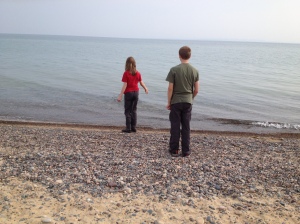 Again I’ve been disappointed while on the internet. I should know better than to expect scientific accuracy and critical thinking skills in the world of social media, where opinions are valued over truth, and truth is often “Because I said so” or “Because someone on the internet said so.” It’s circular reasoning reinforced by ego and emotion. No matter how many times I blunder, trying to inject scientific rigor and critical thinking into conversations filled with fear, supposition, and emotion, I don’t seem to learn that far too many adults don’t understand enough science or have enough critical thinking skill to navigate today’s information-filled world.
Again I’ve been disappointed while on the internet. I should know better than to expect scientific accuracy and critical thinking skills in the world of social media, where opinions are valued over truth, and truth is often “Because I said so” or “Because someone on the internet said so.” It’s circular reasoning reinforced by ego and emotion. No matter how many times I blunder, trying to inject scientific rigor and critical thinking into conversations filled with fear, supposition, and emotion, I don’t seem to learn that far too many adults don’t understand enough science or have enough critical thinking skill to navigate today’s information-filled world.
If pressed today to pick two skills essential to teach our children and ourselves, I’d pick an understanding of science and the ability to think critically. I’ve not the hubris to suggest an entire list of most important skills to teach your child, whether they learn at home or at school. The list would grow long and be impossible to order, as we live in a world where life is far more complicated than a hundred years back. Reading. Writing. Math. Government (and history). Housekeeping. Cooking. Personal finance. Swimming. Apologizing. Interviewing. Music and art, or at least the appreciation of them. Rudimentary social skills. How to be wrong. How to use your computer and phone, and how to help your grandmother do the same. Patience. Promptness. Someone stop me, please!
When I watch the reality show that is social media and read through what passes as reporting on politics, science, current events, health, and nutrition, I realize that two skills are poorly lacking for many people, even degreed and credentialed people: the ability to think critically and a basic knowledge of the mechanisms of science and the scientific process. These basic skills often are required in tandem, although there is plenty of need to employ them independently of each other. I need critical thinking to decide if a source I’ve found is objective and informed. I need an understanding of science to appreciate where that doctor is going with that long, flexible tube and just what he expects to find and why I should care.
Many times we need both. Understanding the infectious diseases that fill the news and our world — Ebola, measles, malaria, influenza, and more – requires some basic understanding of virus versus bacteria and immunology, but it also requires the ability to think about risk without letting fear cloud our judgement. It takes critical thinking to appreciate risks correctly — the risks of acquiring those disease ourselves, the risks inherent in the ways we treat those with the diseases, and the risk to the world’s divergent populations if we don’t. Public health touches private health in ways that can benefit or harm either, and it takes merging science with critical thinking to see how that works.
In our highly technical world, where so much of what we encounter each day has a chip and is run by a program, comfort with science and skills in critical thinking are more important than ever. How many of us understand the basic way computer programs work or even what an algorithm is? Not the programming languages themselves that are behind our Angry Birds, Messenger, Facebook, Instagram, Google Everything, and Pandora, but the basics of the stuff of programming. On and off; ones and zeros; procedures, loops, and subroutines. Whether we’re wired overtly or not, computers and the programs that tell them what to do are woven into our daily lives, keeping inventory in grocery stores, managing countless systems in our cars, and protecting our well-earned money. Thinking logically, part of critical thinking, paired with some basic knowledge of physics, can help us better appreciate what limits (and doesn’t limit) technology today. You can be certain that hackers have at least some critical thinking skills in place and not a small amount of computer science skill as well. While we may not be able to keep up with every advance or learn any programming language in its entirety, understanding more about these ubiquitous systems is wise.
In my next two posts, I’ll explore what I see as the desirable skills in critical thinking and science and pose some suggestions for how to pass those skills onto our children while developing them in ourselves. I’ll recommend a bit of curriculum to help these processes along. I’ll share what I’ve done at home to nurture these skills in my boys as I help them to grow into adults who better understand their world and know how to find out more about that world in a way that’s smart and responsible. Passing on these skills guarantees them years of frustration with those they may meet in social media, at meetings at work, and in their personal lives, but knowing they will leave the nest asking questions and pulling from their bank of scientific understanding helps me sleep a bit more easily.

